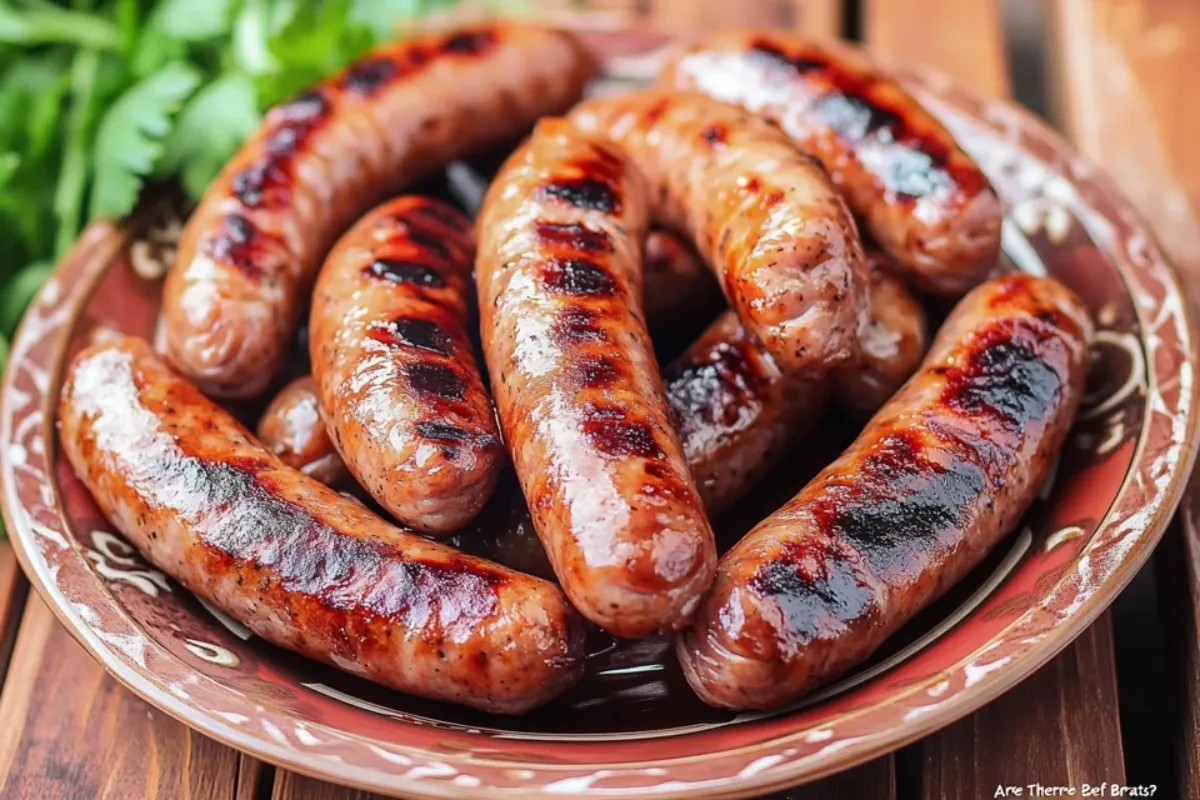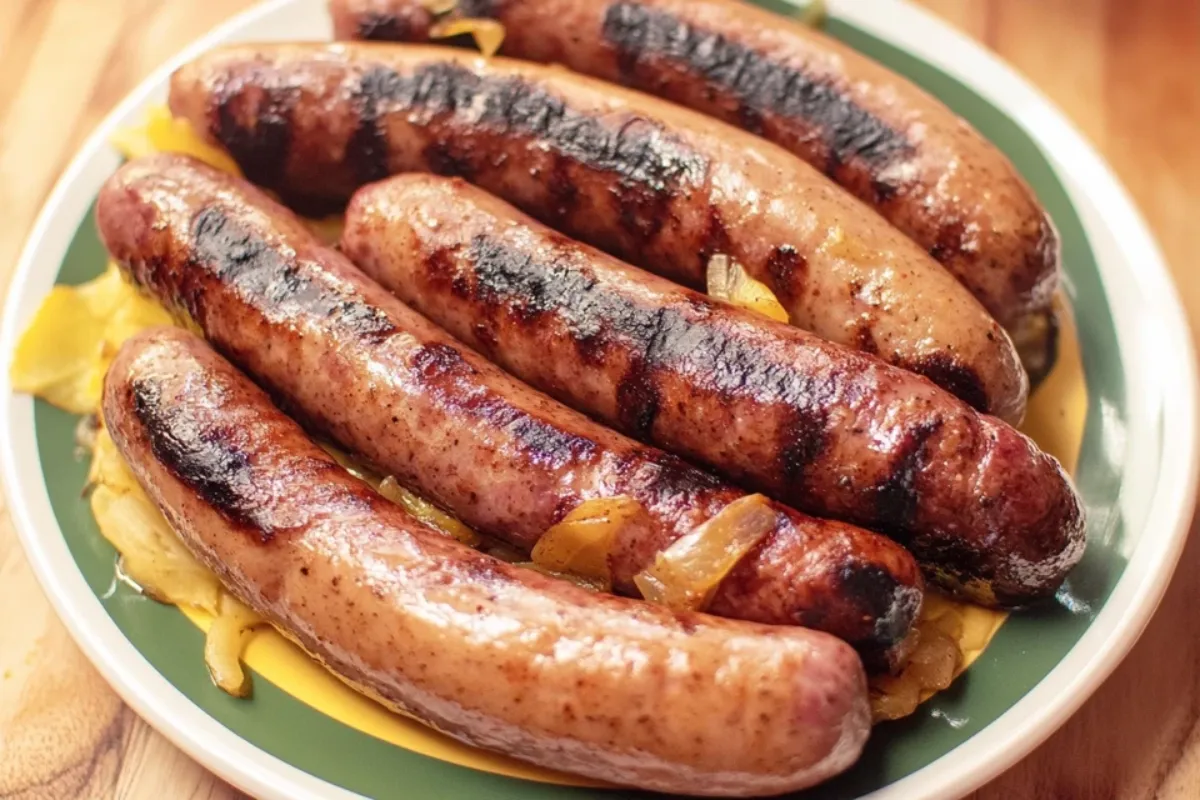If you love sausages, you might have heard of “bratwurst.” You might wonder about the different kinds of brats out there. While traditional bratwurst is made from pork, beef brats are becoming more popular. In this article, we’ll explore bratwurst’s origins, the meats used, how to cook them, and how to serve them.
Bratwurst is a big part of German food culture. It has a long history, from traditional pork recipes to modern beef and mixed meat versions. This guide will help you understand the different bratwurst types and how to enjoy them.
Key Takeaways
- Bratwurst is a type of German sausage that can be made with a variety of meats, including pork, beef, and blends.
- While pork is the traditional meat used in classic German bratwurst, beef-based variations, often called “beef brats,” have gained popularity in recent years.
- The origins and cultural significance of bratwurst trace back to German heritage and traditional recipes.
- Bratwurst can be cooked using various methods, such as grilling, pan-frying, and oven-baking, each with its own unique flavor profiles and cooking considerations.
- Bratwurst is often served with classic accompaniments like sauerkraut, mustard, and beer, but can also be enjoyed in a variety of creative ways.
Understanding Traditional Bratwurst Origins
The history of German bratwurst goes back centuries. It’s rooted in Germany’s rich culinary traditions. Bratwurst, a type of sausage history, is a big part of German culture. It’s loved as a comfort food and a symbol of national pride.
German Heritage and Cultural Significance
Bratwurst is a big part of German society. It shows the country’s culinary diversity. From Bavaria’s smoky sausages to central Germany’s spicy ones, each traditional recipe has its own flavor and technique.
Historical Development of Bratwurst
The story of bratwurst starts in the 13th century. German butchers and sausage makers tried new things with meat, seasonings, and methods. Over time, bratwurst became a big deal at festivals and everyday meals.
When German immigrants came to the United States, they brought their bratwurst recipes. This made bratwurst popular in America too.
Are There Beef Brats?
Many think beef brats don’t exist, but they do. They’re gaining fans in the US sausage market. Unlike the usual bratwurst made from pork, beef sausage varieties offer a new take on this German favorite.
Modern Variations of Beef Bratwurst
Today, you can find many beef brats to suit different tastes. Options include all-beef, beef and pork mixes, and even spicy or cheesy ones. These modern bratwurst choices give people a tasty sausage option without pork.
Popularity and Availability in the US Market
The beef brats are becoming more popular in the US sausage market. Big brands and local makers are creating their own versions. Stores like Johnsonville, Eckrich, and local butchers now carry beef sausage varieties alongside traditional pork bratwurst. This meets the changing tastes of American consumers.
| Brand | Beef Bratwurst Variety | Availability |
|---|---|---|
| Johnsonville | All-Beef Bratwurst | Widely available at major grocery stores |
| Eckrich | Beef and Pork Bratwurst Blend | Found in many supermarkets and specialty shops |
| Local Butchers | Specialty Beef Brats (e.g., Jalapeno, Cheddar) | Typically available at regional or local markets |
Classic Pork Bratwurst vs Beef Varieties
Pork bratwurst is the top pick for many. But beef bratwurst is gaining fans for its unique taste. Let’s look at what makes pork and beef bratwurst different.
Pork bratwurst is known for its savory flavor and firm texture. The fat in pork makes it creamy and keeps flavors in. Beef bratwurst, on the other hand, is leaner and has a meatier taste. It’s a heartier option for those who like a stronger flavor.
Pork bratwurst has more fat and calories than beef. But beef has more protein, which is good for those watching their diet. So, the choice between pork and beef brats depends on what you like and need.
| Characteristic | Pork Bratwurst | Beef Bratwurst |
|---|---|---|
| Flavor | Rich, savory | Bolder, meatier |
| Texture | Firm, juicy | Leaner, denser |
| Fat Content | Higher | Lower |
| Protein Content | Moderate | Higher |
Whether you love pork bratwurst or beef, both are great for grilling or simmering. Try different types to find your favorite. It’s all about what you like and need.
Popular Types of Bratwurst Meat Combinations
Bratwurst comes in many flavors, not just pork. Meat fans can try bratwurst varieties like single-meat sausages or meat blends and specialty sausages. There’s a whole world of regional brats to explore, each with its own taste and traditions.
Single Meat Options
For a traditional taste, pork bratwurst is great. But, veal, chicken, and turkey bratwurst varieties offer new flavors. These sausages have their own tastes and textures, pleasing many palates.
Blended Meat Varieties
New meat blends are all the rage, mixing proteins for unique bratwurst varieties. Beef and pork is a classic mix, with a great taste. Cheesy, herby, and spicy specialty sausages are also out there, thanks to creative cooks.
Specialty and Regional Variations
Step out of the ordinary and try regional brats. Each German and European area has its own bratwurst varieties. From Nuremberg-style to Coburger, these specialty sausages show off local cooking traditions.
| Bratwurst Variety | Meat Composition | Flavor Profile |
|---|---|---|
| Nuremberg-style | Pork | Delicate, slightly smoked |
| Coburger | Veal and pork | Mild, creamy texture |
| Thüringer | Pork and beef | Hearty, subtly spiced |
| Bavarian-style | Pork, veal, and sometimes beef | Robust, slightly garlicky |
How to Choose the Best Bratwurst for Your Needs
Choosing the right bratwurst is key. You want the best quality sausage for your needs. Look at the meat content and sausage casings to make the best choice.
Start by checking the meat content. Bratwurst usually has pork and veal. But, some may have beef or other meats too. Make sure the label tells you what’s inside.
Also, check the sausage casing. Natural casings, like those from sheep or hog intestines, are best. They give a real taste and feel. Synthetic casings are uniform but might not taste as good.
| Casing Type | Texture | Flavor |
|---|---|---|
| Natural Casings | Slightly Irregular | Richer, More Authentic |
| Synthetic Casings | Uniform | More Subtle |
Choose a bratwurst that fits your taste and needs. Whether for grilling or adding flavor to dishes, the right choice makes a big difference. Enjoy every bite!
Cooking Methods and Temperature Guidelines
Choosing the right cooking method is key to making tasty bratwurst. You might like the smoky taste of grilling brats, the crispy outside of pan-frying sausages, or the easy oven-baking. It’s important to use the right techniques and temperatures to cook your brats just right.
Grilling Techniques
Grilling gives you a true German cooking bratwurst taste. Heat your grill to 375-400°F. Place the brats on the grates and turn them often until they hit 160°F inside. This makes them juicy and fully cooked.
Pan-Frying and Oven Methods
Grilling not your thing? Pan-frying or oven-baking are great choices. In a skillet, cook the brats over medium heat for 12-15 minutes, turning them often. For oven baking, set it to 400°F and cook for 15-20 minutes, flipping them halfway. Both ways, aim for an internal temperature of 160°F.
Common Cooking Mistakes to Avoid
To cook your cooking bratwurst perfectly, avoid some common mistakes. Don’t overcrowd the grill or pan, as it can steam instead of sear. Also, don’t cut into the sausages to check if they’re done. This lets juices out. Use a meat thermometer to check the internal temperature for the best results.
Seasoning Profiles and Flavor Differences
Bratwurst seasonings and sausage spices can be very different. Traditional German bratwurst uses spices passed down for centuries. But, modern versions mix in regional seasonings and new flavors.
Classic bratwurst is known for nutmeg, caraway, and pepper. These spices give it a savory, sweet, and spicy taste. But, different areas in Germany add their own spices like garlic and ginger.
| Traditional German Bratwurst Seasonings | Regional Bratwurst Flavor Variations |
|---|---|
|
|
In the U.S., bratwurst has become popular. This has led to many sausage spice blends. You can find everything from spicy to herbal flavors. Whether you like traditional German or American-style, knowing about bratwurst seasonings helps you find your favorite.
Serving Suggestions and Traditional Accompaniments
Bratwurst is a tasty German sausage that goes well with many classic sides and drinks. To enjoy its full flavor, try it with traditional dishes that match its taste.
Classic Side Dishes
Sauerkraut is a must with bratwurst. It’s tangy and adds a nice contrast to the sausage. It also helps with digestion.
German potato salad is another great choice. It’s creamy, made with potatoes, onions, and a tangy dressing. These sides make your bratwurst taste even better and honor its German roots.
Beer Pairings and Beverages
Bratwurst and beer are a perfect pair. A German lager or pilsner’s malty, hoppy taste goes well with the sausage. Try a Paulaner or Weihenstephaner beer for a real German taste.
If you don’t drink beer, apple cider or Fanta soda are good choices. They’re bubbly and refreshing, making a great match for bratwurst.
FAQ:
Are Johnsonville brats beef or pork?
Johnsonville brats are primarily made with pork. Johnsonville, a well-known sausage brand in the United States, traditionally uses high-quality pork as the base for their classic bratwurst recipes. Their original brats, beer brats, and other popular flavors predominantly feature pork as the main ingredient, complemented by a blend of spices and seasonings to enhance flavor.
However, Johnsonville also offers other varieties to cater to diverse preferences:
- Beef brats: Some Johnsonville products are made entirely with beef, providing a different taste and texture for those who prefer or require a pork-free option.
- Turkey or chicken brats: For those seeking a leaner alternative, Johnsonville produces brats made with poultry.
To confirm the type of meat in a specific product, always check the ingredient list on the package.
Are Costco brats beef or pork?
Costco’s bratwurst offerings typically feature pork. The brats sold at Costco, including those under their Kirkland Signature brand or from other suppliers like Johnsonville, are traditionally pork-based. These sausages are designed to have a rich, juicy flavor that comes from the fat content in pork, making them ideal for grilling or pan-frying.
However, Costco may also carry:
- Beef bratwursts: Some locations stock all-beef options for customers who prefer a pork-free alternative.
- Chicken or turkey brats: These are occasionally available as a healthier, leaner option.
The availability of beef or alternative meat brats may vary by store and region, so checking the product label or asking Costco staff is a good idea.
Are beef or pork brats better?
The choice between beef and pork brats depends on personal preference, dietary needs, and the dish being prepared. Here’s a comparison to help you decide:
Flavor and Texture:
- Pork brats: These are known for their rich, juicy flavor and tender texture. Pork has a slightly sweeter and milder taste, making it a classic choice for traditional bratwurst recipes.
- Beef brats: These have a deeper, heartier flavor with a firmer texture. The bold taste of beef pairs well with robust seasonings, creating a distinctive profile.
Cooking Versatility:
- Pork brats excel in traditional grilling or beer-braising, offering a juicy bite that many associate with classic bratwurst.
- Beef brats are ideal for those looking for a unique twist or a pork-free option. They also work well in spicy or smoky recipes.
Nutritional Considerations:
- Pork brats: These are higher in fat content, which enhances their flavor and juiciness but increases calories.
- Beef brats: Typically leaner, these are a good choice for individuals looking to reduce fat intake while still enjoying a flavorful sausage.
Dietary Preferences:
- For those avoiding pork for dietary or religious reasons, beef brats provide a satisfying alternative.
- Pork brats remain the go-to for a traditional bratwurst experience.
Both options are delicious, but pork brats are better for traditional recipes, while beef brats offer a unique taste and versatility.
Are beef brats the same as hot dogs?
No, beef brats and hot dogs are not the same, even if they share some similarities. Here’s a detailed comparison:
Ingredients:
- Beef brats: Made from coarsely ground beef with a robust blend of spices like garlic, nutmeg, and caraway seeds.
- Hot dogs: Often made from finely emulsified meat (beef, pork, or a combination), with a simpler seasoning mix.
Texture:
- Beef brats: Have a chunky, hearty texture due to the coarsely ground meat.
- Hot dogs: Smooth and uniform, as the meat is finely processed into a paste-like consistency.
Size and Shape:
- Beef brats are typically larger, thicker, and plumper than hot dogs.
- Hot dogs are thinner and more uniform in size.
Flavor:
- Beef brats: Rich and bold, with spices that give them a savory, peppery profile.
- Hot dogs: Milder in taste, with a focus on simplicity.
Cooking Methods:
- Beef brats are grilled, pan-fried, or braised in beer for a flavorful crust and juicy interior.
- Hot dogs are usually boiled, steamed, or grilled, emphasizing convenience and quick preparation.
While both are popular sausages, beef brats offer a more robust and traditional flavor, while hot dogs are simpler and more convenient.
Conclusion
Bratwurst, a beloved part of German food culture, has evolved over the centuries to include diverse types and flavors. From traditional pork bratwurst to modern beef variations, these sausages offer something for everyone. Whether you prefer the rich, juicy taste of pork or the hearty, bold flavor of beef, bratwurst continues to be a versatile and satisfying choice for meals. Cooking methods like grilling, pan-frying, or beer-braising bring out the best in these sausages, and classic sides like sauerkraut and potato salad complete the experience.
With growing popularity and availability, bratwurst has become a staple in American cuisine as well. By understanding the origins, ingredients, and preparation techniques, you can enjoy bratwurst in its many forms and flavors. Whether served traditionally or with a creative twist, bratwurst remains a timeless and delicious dish to savor.


